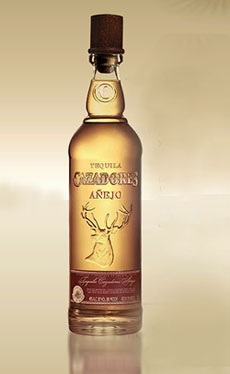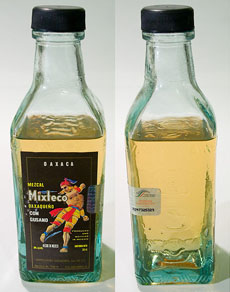

Añejo, or “aged” tequila, is one of the five types of tequila. Photo courtesy Tequila Cazadores.
|
LEAH HANSEN is an Editorial Assistant for THE NIBBLE.
|
|
August 2009
Last Updated July 2010 |
 |
Tequila Types
Five Different Tequila Types & The “Tequila Worm”
This is Page 2 of a five-page article. Click on the links below to visit other pages.
Types Of Tequila
The five types of tequila are:
- Blanco Tequila (“white”) or plata (“silver”): clear and transparent, the tequila is bottled or stored immediately after distillation, or aged no more than two months.
- Joven Tequila (“young”) or oro (“gold”): un-aged tequila blended with rested or aged tequilas; caramel coloring, sugar-based syrup, glycerin, and/or oak extract are often added in order to resemble aged tequila.
- Reposado Tequila (“rested”): light yellow and translucent, the tequila is aged for at least six months but less than a year. Reposado began to emerge as a new category of tequila in the late 1980s.
- Añejo Tequila (“aged” or “vintage”): brighter yellow, aged at least one year, but less than three years.
- Extra Añejo Tequila (“extra aged” or “ultra aged”): a golden color, aged at least three years in oak.
The blue agave itself takes 8 to 12 years to reach full maturity, so the tequila you drink has taken quite a long time to reach your tongue.
The Tequila Worm
Many people believe that some tequilas have a worm in the bottle. They don’t; but certain brands of mezcal do contain a worm, the larval form of the moth Hypopta agavis, which lives on the agave plant.
The larvae are used by several brands of mezcal to give flavor to the spirit. As a marketing gimmick that began in the 1940s, some brands put a worm in the bottle. Any flavor from the worm has long been removed during production.
According to the website Mezcal-de-Oaxaca.com, in 2005 the Mexican government legislated to remove the worm from mezcal (it was already prohibited in tequila). One reason is that at 20¢ to 40¢ per worm and between 200-500 worms per plant, irresponsible harvesters actually uproot and destroy an agave plant to harvest the worms.*
|
|

The “tequila worm,” actually the mezcal worm, can be seen at the bottom of the bottle at right. Photo by JC Maco | Wikimedia. |
Source: http://www1.american.edu/TED/mezcal.htm
Tequila should not contain an insect of any kind, and if it does, then “you’ve either purchased gag-inducing hooch aimed at gullible gringos, or your top-shelf booze is infested by some kind of alcohol-breathing, alien bug,” according to author James Waller (Drinkology: The Art and Science of the Cocktail, page 224, published 2003).
Continue To Page 3: Tequila Cocktail Recipes
Go To The Article Index Above
All materials

|





